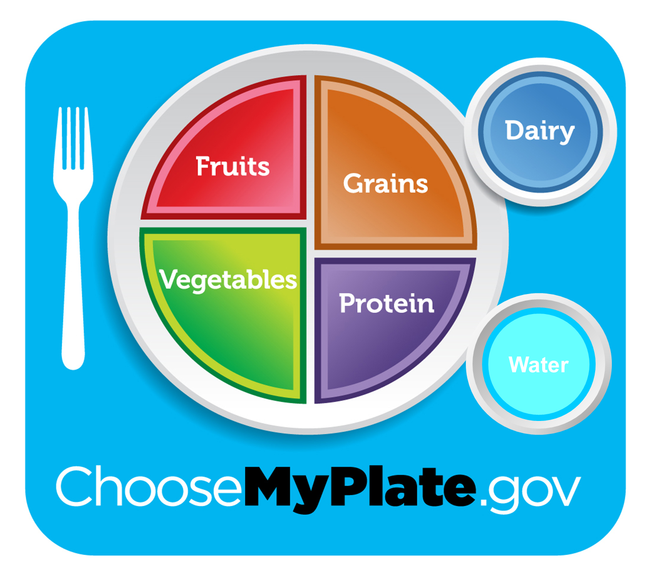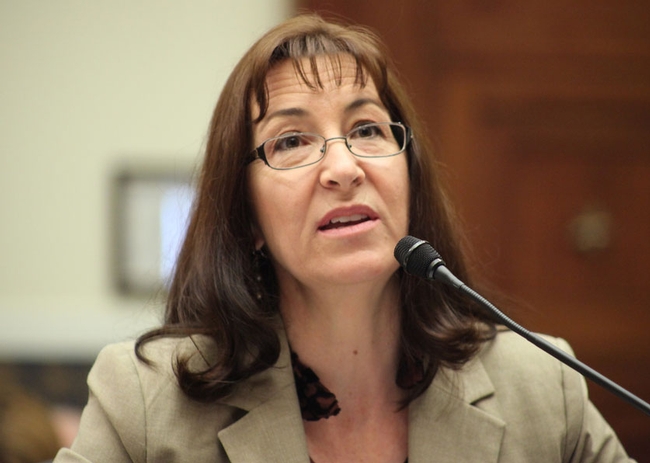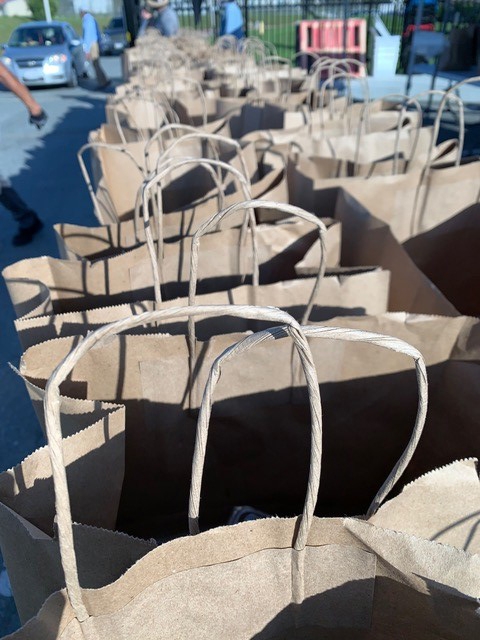
Posts Tagged: Christina Hecht
California heroes continue to provide nutritious food to students
Now more than ever, California is full of heroes: front-line workers in our hospitals, farm fields and essential businesses. And even though schools are closed, they are full of heroes, too: teachers implementing distance learning and kitchen workers who have stepped up to the heroic task of providing meals for children in their communities, despite the challenges that have come with the COVID-19 pandemic.
School nutrition professionals continue to provide nutritious food that meets dietary standards, the kitchens provide employment, and the hungry students provide a multi-million dollar market for California's agricultural products.
Researchers at UC Agriculture and Natural Resources's Nutrition Policy Institute received an email earlier this spring with a subject line that simply said, “HELP!!!” Local community groups had learned that some Central Valley school districts would not be providing meals over spring break. Even though that might not be cause for alarm some years, this year it would hurt. In the eight-week period between March 14 and May 14, 2020, the California Employment Development Department processed 4.7 million unemployment benefit claims – nearly seven times more claims than over a two-month period at the height of the 2008 recession. EDD estimates that California unemployment reached nearly 25% by mid-May.
That is why school meals are more important than ever.
On receiving the request for HELP!!!, the Nutrition Policy Institute teamed with a Stanford pediatrician to distill critical information from USDA and the California Department of Education. Connecting with child nutrition professionals throughout the state, they gleaned tips and best practices, and added COVID-19-specific resources from the Community of Practice convened by LunchAssist and the Center for Ecoliteracy. The team produced informational flyers targeted to California school district officials and food service directors:
- Child Hunger Doesn't Take a Spring Break (2-pager)
- Calling all Districts! USDA Summer Meals Can Keep Kids Healthy (4-pager)
The resources provide explanations and resources for operating school meal programs during non-instructional periods through either the Seamless Summer Option (SSO) or the Summer Food Service Program (SFSP).
There is no time to lose. Click here to make sure your local school district's food services division is taking advantage of the many strategies that can support children's nutrition this summer.
The UC Nutrition Policy Institute drives a drinking water movement

The alliance aims to make plain water the easy, appealing substitute for sugary beverages – soda, energy drinks, fruit drinks, and sweetened coffee and tea drinks. The alliance is also actively working on the safety of tap water in the nation's schools and childcare settings.
“To make water the beverage of choice will require a movement,” said Christina Hecht, a member of the NPI team. “NPI will build bridges, spearhead the creation of shared resources, align messages, strategies and aims, and coordinate strong external communications.”
NPI was formed by UC Agriculture and Natural Resources in 2014 to conduct, evaluate and share research related to the impact of nutrition and physical activity on public health. The W.K. Kellogg Foundation has awarded NPI a $960,000 grant to coordinate the National Drinking Water Alliance for three years.
“Even when water is available, too many children and adults choose sugar-sweetened beverages,” said Hecht, who will serve as the National Drinking Water Alliance coordinator. “In our American diet, sugary drinks are the top source of added sugars for both adults and children, and, remarkably, they are the single largest source of calories for teens aged 14 to 18.”
But Hecht is quick to point out that if people are to make the switch to water, water needs to be easily accessible and they need to know that it is safe to drink.
High consumption of sugar-sweetened drinks is associated with obesity and other chronic health problems, such as heart disease and diabetes. UCLA scientists reported in March that the diabetes epidemic in California is “out of control.” The study says 55 percent of the state's population has prediabetes or diabetes – many of them are undiagnosed.
“Simply switching to water is a relatively easy lifestyle change that can have a big impact on the intake of added sugar and excess calories, reducing diabetes risk,” Hecht said. “It can also improve oral health.”
The National Drinking Water Alliance includes government agencies, education officials, researchers, water industries, and non-governmental organizations like the Center for Science in the Public Interest, American Academy of Pediatrics Campaign for Dental Health, and the American Heart Association. They believe by sharing knowledge, resources and connections, they will hasten progress toward their common goal.
Fortunately, the current state of safe drinking water in the U.S. is mostly favorable. About 90 percent of Americans get their water from public utilities and 95 percent of those supply safe water. In some areas, however, water can become contaminated on the path between utility and tap, typically with lead. Sometimes other contaminants can leach in through breaks in pipes.
“We all recognize that, if we are going to tell people to drink water, they need to have confidence that the tap water is safe,” Hecht said. “At the moment, we don't know the magnitude of the problem of unsafe drinking water. The alliance is highly focused on policy as the most effective tool to bring about broad change.”
The National Drinking Water Alliance plans a Congressional hearing on national drinking water and is developing best practices for effective access to safe drinking water in schools and childcare settings.
Avoiding the water quality problems suffered in Flint

Congress and health groups are looking at a provision of a 2010 child nutrition law to get schools to test their water, and considering how to help schools pay for it.
The Politico reporter spoke to Christina Hecht, a senior policy adviser at the UC ANR Nutrition Policy Institute. The institute is the hub for the National Drinking Water Alliance, a network of organizations and individuals across the country working to ensure that American children can drink safe water in the places where they live, learn and play.
Hecht pointed out that the Healthy Hunger-Free Kids Act of 2010 requires schools to provide potable water during meal times. The act also says that child care facilities that participate in federal meals programs must give kids access to drinkable water throughout the day.
Because of this wording in the law, USDA could issue a guidance requiring schools to test their water to be sure it is potable.
"The beauty of this approach is that the language is there ... the means for oversight is there," Hecht said. "When you look at Flint, where does the buck stop? When you look at schools and child care, we've identified where the buck stops."
The cost to test water at schools nationwide is estimated to be about $7.6 million. For adult and child-care sites it would be about $14 million. In all, the expenditure works out to about 40 cents per child.
"We at the Nutrition Policy Institute encourage Congress to appropriate funds for tap water testing in American schools, and remediation where necessary," Hecht said.
Scientists ask USDA to add water to MyPlate

Ritchie has joined with dozens of nutrition and health professionals around the country to ask that the USDA put water onto MyPlate.
“We don't have all the answers to overcoming obesity, but the research on sugar-sweetened beverages is very clear,” Ritchie said. “When you drink beverages like soda, sports drinks or punch, the sugar gets absorbed very rapidly and the body doesn't recognize the calories. The result is excess calories and weight gain.”
The USDA introduced MyPlate in 2011 to reflect the message of its Dietary Guidelines for Americans, 2010. Federal law requires that the guidelines be reviewed, updated and published every five years.
“USDA officials say that, in order to change MyPlate, there must be more information in the dietary guidelines about water,” Ritchie said. “We are working through the public comment process to ask the advisory board to promote water as the beverage of choice.”
The ultimate goal – a new water icon on MyPlate – is important because of its high visibility. MyPlate is found on elementary school classroom walls and cereal boxes; at community gardens and the grocery store produce aisle.

“They see MyPlate as the face of the dietary guidelines and are very supportive of using the image as a teaching tool,” Hecht said. “They also supported the idea of adding a symbol for water.”
She shared the California educators' thoughts on MyPlate with her USDA contacts. “When they get a story from the field, it really matters to them,” Hecht said.
Ritchie and her colleagues around the country submitted a “Best of Science” letter to the Dietary Guidelines Advisory Committee imploring them to strengthen the language for drinking water.
“Current research indicates that children, in particular, are subject to ‘voluntary dehydration' from low intake of plain water,” the letter says. “Between 2005 and 2010, more than a quarter of children aged 4 to 13 years old in the U.S. did not have a drink of plain water on two consecutive days.”
Instead, they are drinking sugary beverages. National surveys in the early 2000s found that, on any given day, 84 percent of 2- to 5-year-old children drank sugar-sweetened beverages like sodas, sports drinks and fruit punch. The calories amounted to 11 percent of the children's total energy intake.

- Sugar-sweetened beverages – including sodas, juice drinks, pre-sweetened tea and coffee drinks, and fortified or energy drinks – are among the top sources of calories for children and adolescents.
- Between the late 1960s and early 2000s the consumption of sugar-sweetened beverages doubled.
- While the American Heart Association recommends no more than 6 teaspoons of added sugars per day for women and 9 teaspoons per day for men, the average U.S. consumption is 17 teaspoons per day.
- Low-income populations have higher intakes of sugar-sweetened beveragesand Latino children drink more of them than white children.
- Cardiovascular disease, present in more than one-third of American adults, is now understood to be exacerbated by the inflammatory effects of excess sugar consumption.
- Excess sugar consumption is a risk factor for non-alcoholic fatty liver disease, a precursor to diabetes.
Best of Science Letter


